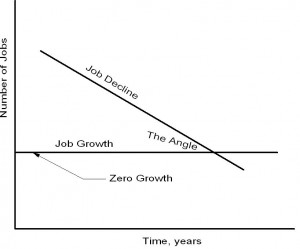Since the start of the new century, technology no longer creates new jobs
By: James Lyman BSAE, BSEE, MSSM
Economic & Finance Report
In the daily news, we often hear the statistic that 20 to 25% of newly graduated college students are unemployed or underemployed. Worst still, the bulk of these people hold massive student loan debt, so with low to no income, repayment is very questionable. But the future of these new workers is even more bleak with the continual elimination of jobs by automation coupled with zero job growth since the start of the millennium.
Recent research by Carl Frey and Michael Osborne1 into the future impact of computerization to the work force has found that as much as 47% of the jobs will disappear in the next twenty years. They modeled the job market by looking at over seven hundred job fields, making estimates of how much each job field will be replaced by computer based technology. Their objective was to explain the shift in the labor market, where labor is shifting from middle-income manufacturing down to low-income service occupations. It doesn’t bode well for the young graduates of America with as much as half the jobs disappearing in the next two decades.
Worst yet, the creation of new jobs has gone flat. Research by Erik Brynjolfsson and Andrew McAfee, their findings published in their book “Race Against the Machine” 2, shows that in the twentieth century, from after World War II, technology has driven job growth at a very healthy rate, but for the last few decades this growth has declined. By the turn of the century, that grow became flat, so for the last fifteen years, there hasn’t been any new job growth. More and more, the youth of America are left with low paying service industry jobs with no prospects or future. They find themselves obsolete before they even finish school and start life!
This figure best illustrates their dilemma, where the flat line “Job Growth” shows how the quantity of jobs in America is no longer growing, and therefore no new jobs are being added to the economy. As per the Osborn report (Google osborn, report and pdf for a copy), the downward sloping line “Job Decline” shows that the number of jobs is actually decreasing because of technology. The new graduates are between these two lines slowly being compressed and channeled down
towards their intersection . . . The Angle.
I’m reminded of the infamous Bloody Angle of the battle of Gettysburg, a stone wall which changed direction to form an angle. In the battle, Pickett’s charge converge on this rock wall, the angle serving to channel the Confederate troops into a Federal killing zone that savaged the Confederates. Although the Confederates did manage to break through, they were so weaken, that the Angle was their high water mark, so they were unable to hold their gains. The attack failed with devastating losses.
The two converging lines of this Angle is doing the same thing to America’s youth, channeling them into an untenable position leaving them with no hope and no future. Like the Confederates in Pickett’s charge, they are loss to the Angle. So far, the youth of America, the millenniums, haven’t figured out what is happening to them, that their situation isn’t temporary, rather it’s permanent. They think that their station in life is just temporary, an artifact of the recession, that things will improve as the economy returns to the glory days of their parents. They haven’t accepted that they are out, obsolete and discarded by a technological society which no longer wants or needs them, or has any real use for them.
In today’s news, you hear about surveys showing the bulk of Americans feel the future for the young wont be as bright as their’s was, that while for past generations, life has continually gotten better, for the future generations, they feel it will be far less. The Angle shows why their fears are so well founded. It shows how so many of the youth are being squeezed out of the social economic system. Why there is little to no future for so many college graduates, and why there’s growing discontent among students across college campuses. They want changes, but just don’t know what changes they want made.
And so far, there hasn’t been one peep about this major facet of our economy in the political rhetoric of the coming sixteen election.
1) “The Future of Employment: How Susceptible are Jobs to Computerization?”, Carl Benedikt Frey and Michael
A. Osborne, University of Oxford, Oxford, United Kingdom, September 17, 2013
2) “Race Against The Machine, How the Digital Revolution is Accelerating Innovation, Driving Productivity, and Irreversibly Transforming Employment and the Economy”, Erik Brynjolfsson and Andrew McAfee, Digital Frontier Press, Lexington, Massachusetts, 2011.

